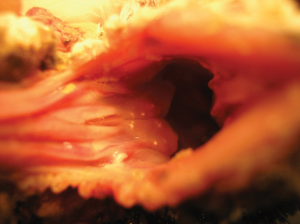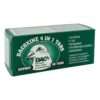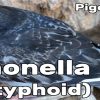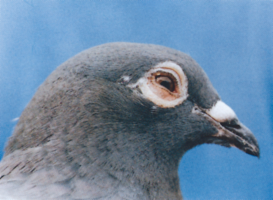
Mycoplasma Respiratory Infections in Pigeons: A Diagnostic Challenge
Respiratory infections are among the most common health issues affecting pigeons, and Mycoplasma infections, in particular, can be one of the most difficult to diagnose. These infections often mimic other respiratory diseases, making it challenging for pigeon fanciers to pinpoint the exact cause of illness without specialized testing. Mycoplasma infections can weaken pigeons, reducing their racing performance and overall well-being. Understanding how to recognize symptoms, properly diagnose, and manage these infections is essential for maintaining a healthy loft.
Understanding Mycoplasma Infections in Pigeons
Mycoplasma infections are caused by Mycoplasma bacteria, a type of microorganism that differs from other bacteria due to its lack of a cell wall. This characteristic makes it resistant to certain antibiotics and difficult to culture in a laboratory. In pigeons, Mycoplasma primarily affects the respiratory system, causing inflammation and excessive mucus production, which can lead to breathing difficulties and secondary infections.
The severity of the infection can vary, with some pigeons showing only mild symptoms, while others develop serious respiratory distress. The disease can spread quickly, especially in crowded loft conditions, making early detection crucial for preventing outbreaks.
Symptoms of Mycoplasma Respiratory Infections
Pigeons suffering from a severe upper respiratory Mycoplasma infection typically display distinct symptoms that can help fanciers recognize the issue early. Some of the most common symptoms include:
- Inflammation in the mouth and throat: The choana, a slit-like opening in the roof of the mouth, may appear swollen, partially closed, or covered with mucus.
- Excessive mucus production: A bubbly mucus may be seen draining from the sinuses into the mouth, often indicating sinus congestion.
- Swollen pharyngeal tonsil: This triangular structure located on the palate may become red and inflamed as the infection progresses.
- Loss of choanal spicules: The small fringed edges around the choana may become damaged and disappear due to inflammation.
- Blue discoloration of the mouth lining: This can indicate a lack of oxygen in the bloodstream, a sign of more severe respiratory distress.
- Mucus accumulation at the beak margins: In some cases, mucus dries and turns yellow, particularly in advanced infection
-
Tonsillitis – the inflamed tonsils are visible as the triangular bright pink area in the roof of the mouth. The row of spicules, known as ‘the fringe’ has been lost. This bird has an established respiratory infection. The glottis (entrance to the windpipe) is rounded, the mucous membranes (lining) of the mouth are slightly blue and the tongue tip is discolored all consistent with increased respiratory effort and decreased oxygen levels in the blood.
-
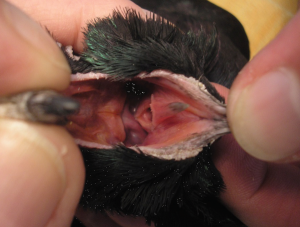
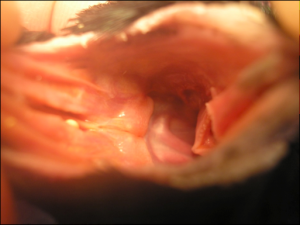
One key challenge in diagnosing respiratory infections in pigeons is distinguishing normal mucus from infection-related mucus. Pigeons naturally produce mucus in the crop, which can sometimes move into the throat after feeding or exercise. For this reason, pigeon keepers should assess mucus levels when birds are at rest rather than immediately after they have eaten.
Why Is Mycoplasma Difficult to Diagnose?
Unlike other bacterial infections, Mycoplasma is notoriously difficult to detect in live pigeons. This is because:
- It is a fragile organism that does not grow well in standard bacterial cultures.
- Specialized diagnostic tests are required, and only advanced laboratories can perform them.
- It can exist in a carrier state, meaning some pigeons may harbor the infection without showing symptoms but can still spread it to others.
Most standard veterinary tests do not include Mycoplasma screening unless specifically requested. However, advanced diagnostic labs offer PCR (Polymerase Chain Reaction) testing, which can identify Mycoplasma DNA from mucus samples. This test is considered one of the most accurate ways to diagnose Mycoplasma infections.
European veterinarians strongly recommend testing lofts before the breeding and racing season to ensure that pigeons are free from Mycoplasma before competition. Even if birds appear healthy, undetected infections can lead to poor race performance and reduced breeding success.
Modern Diagnostic Techniques
Due to the difficulty of culturing Mycoplasma in a lab, veterinarians rely on molecular testing methods to confirm infection. Some of the most effective diagnostic tools include:
- PCR Testing: This method detects Mycoplasma DNA in throat mucus samples, providing a clear diagnosis.
- Microscopic Examination: Increased lymphoid aggregates in the respiratory tract may indicate Mycoplasma infection.
- Observation of White Mucus in the Trachea: Some birds with Mycoplasma infections exhibit a thin white mucus lining the upper trachea.
These diagnostic techniques allow pigeon fanciers to identify and manage Mycoplasma infections more effectively, reducing the risk of widespread outbreaks in their lofts.
Preventing and Managing Mycoplasma Infections:
While Mycoplasma infections can be difficult to eliminate completely, there are several steps pigeon fanciers can take to prevent and manage these respiratory diseases:
1. Maintain Loft Hygiene
- Keep lofts well-ventilated to reduce the risk of airborne transmission.
- Regularly clean and disinfect surfaces to prevent bacterial buildup.
- Avoid overcrowding, as Mycoplasma spreads more easily in densely populated lofts.
2. Monitor Bird Health Regularly
- Check birds for early signs of respiratory distress.
- Observe mucus production and choanal health during routine check-ups.
- Remove and isolate any pigeons showing signs of infection to prevent spread.
3. Test Before Breeding and Racing
- Conduct Mycoplasma testing before the breeding season to prevent passive transmission to offspring.
- Ensure racing pigeons are free from infections before competitions to maximize their performance.
4. Use Appropriate Medications
- If a Mycoplasma infection is confirmed, antibiotic treatments such as Tylosin, Doxycycline, or Enrofloxacin may be recommended by veterinarians.
- Avoid overuse of antibiotics, as Mycoplasma bacteria can develop resistance over time.
. Strengthen the Immune System
- Provide a balanced diet rich in essential nutrients to keep pigeons healthy.
- Use probiotics and immune boosters to support the bird’s natural defenses.
- Minimize stress, as high-stress levels can weaken the immune system and make pigeons more vulnerable to infections.
Conclusion
Mycoplasma respiratory infections in pigeons are among the most challenging diseases to diagnose and manage. Their symptoms closely resemble other respiratory infections, making laboratory testing crucial for an accurate diagnosis. PCR testing and microscopic examination are currently the most effective ways to confirm infection.
By prioritizing loft hygiene, regular health monitoring, and pre-season testing, pigeon fanciers can reduce the risk of Mycoplasma infections and improve the health and performance of their flocks. Implementing a proactive prevention strategy will ensure that pigeons remain in peak condition for breeding, racing, and long-term well-being.
“Until Next time Keep Them Health And Flying”
Would you like more details on specific treatment options, or do you need guidance on a specific case? Let me know how I can help!

